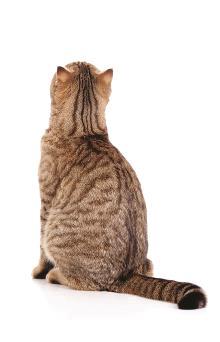Hyperthyroidism
Thyroid hormones are produced in the thyroid gland, which is made up of two lobes located on either side of the windpipe (trachea). Hyperthyroidism occurs when either one or both of the lobes become enlarged. This enlargement leads to the overproduction of thyroid hormones. The reasons for the change in the thyroid gland are not fully known. In 98% of cases, the enlargement of the lobe(s) is benign. In these cases, diagnosis and treatment are generally straightforward and successful. However, in the remaining 2% of cases the enlargement is due to a malignant (cancerous) growth of the thyroid gland. Regardless of the cause of the enlargement, the result is the same: excessive amounts of thyroid hormones are produced that can lead to serious medical problems for your cat.

Common Signs
-
Increased, even ravenous, appetite
-
Weight loss, sometimes severe
-
Increased fluid intake
-
Frequent urination
-
Increased restlessness and irritability
-
Occasional vomiting
-
Diarrhea
-
An unkempt coat
Physical examination
In some cases, the enlarged thyroid lobe(s) are palpable in the cat’s neck. Occasionally, the thyroid gland cannot be easily felt. This happens when the thyroid tissue is located elsewhere, usually inside the cat’s chest.
Diagnostic testing
To confirm the diagnosis, a blood test to measure levels of the T4 hormone is necessary. Although both the T4 and T3 hormones are produced in excess in a cat suffering from hyperthyroidism, total T4 measurement is the most accurate test available. Since most cats with hyperthyroidism are older, comprehensive blood testing and a urinalysis should also be run to assess organ function and ensure they do not suffer from any other problems. Kidney disease, although not directly linked to hyperthyroidism, may develop at the same time since both diseases are common in older cats. Blood tests and a urinalysis are important because other conditions might affect the successful treatment of hyperthyroidism and could also be causing harm.
New research into owner attitudes revealed
New research published in the Journal of Feline Medicine and Surgery1 into the attitudes of owners of hyperthyroid cats has challenged some of our industry’s preconceived ideas.
Dr. Sarah Caney BVSc PhD DSAM (Feline) MRCVS comments, “The survey has shown that cat owners are not a barrier to prescribing twice daily medication. Their overwhelming drive is to provide the best level of care that they can. From an owner perspective, the ideal anti-thyroid medication offers low doses and a variety of dosing strategies to ensure that each individual cat receives the dose they need and no more.”
Treatment
Medical management is recommended as a “first step” for most cases of feline hyperthyroidism. Methimazole is the anti-thyroid drug of choice, and has been used successfully for treating cats in the US for more than 20 years.2,3
1 Caney, S.M.A. (2013) Journal of Feline Medicine and Surgery 15(6): 494–502
2 Peterson ME (2000). Hyperthyroidism. In: Ettinger SJ, Feldman EC (Eds). Textbook of Veterinary Internal Medicine,Volume 2, 5th Edition. WB Saunders Company, Pennsylvania, pp.1400-1419.
3 Peterson ME, Kintzer PP, Hurvitz AI (1988). Methimazole treatment of 262 cats with hyperthyroidism. Journal of Veterinary Internal Medicine 2, 150-157.
If you have any concerns about the health of your animal, please contact your veterinarian.
